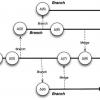 |
Have You Used Word’s "Smell-Check" Features? Terry Wiegmann writes about how Microsoft Word's features, like its spelling and grammar checkers, can help one identify agile smells—those signs that something might be wrong. While we may want to minimize documentation and the use of Word, we can mentally use some of Word’s features to sniff out some whiffs of smells.
|
|
 |
The Bugs That Deceived Me Every time we look at the data, we perform an analysis that helps us make decisions—hopefully the right ones. In this article, Gil Zilberfeld describes a few traps where bug data misled him to make bad decisions. These traps are in the data itself, not the tools, and can lead us in the wrong direction.
|
|
 |
2013: A Year of Software Development and Testing in Quotes In this roundup of noteworthy quotes from industry experts interviewed in 2013, read about what constitutes effective agile methods, the year in testing techniques, and why you shouldn't put too much trust in the latest and greatest tools.
|
|
 |
What Are Your Metrics Trying to Tell You? Joanne Perold writes that you cannot just look at the numbers; the context behind the data is often far more valuable. Metrics can tell a compelling story or provide meaningful information to anyone who wants to pay attention, but when the focus is only on the number, it can be a disaster.
|
|
|
|
New Skills for Software Testers and Software QA Engineers: 2013 … and Beyond! Let's take a look into the future—all the way to the year 2013! As a software tester or software quality engineer, are you planning to learn a new skill in the new year. If you are, make sure you approach it in a way that will make that skill stick.
|
|
|
|
Hours, Velocity, Siloed Teams, and Gantts Johanna Rothman shares some tips for project and program managers turned ScrumMasters who are adopting agile. If your management won’t allow you to take training, start reading.
|
|
 |
Orders of Magnitude in Test Automation Mike Kelly explains the following heuristic approach to help ensure your testing is roughly inline based on orders of magnitude across the various types of automation. It’s not a method for measuring effectiveness. Instead it’s simply a “smell” to tell you when you might need to take a little extra time to make sure you’re focusing your automated testing efforts at the right level.
|
|
 |
End-of-Release Branching Strategies This two-part article explores branching strategies—development tactics that allow teams to work concurrently on different features and maintain the relationship between them. In part one, Steve Berczuk explains what branches are, common types of them, and the tradeoffs between branching styles.
|
|
|
|
Transitioning to Agile Testing Your developers are already working feature-by-feature in iterations, but your testers are stuck with manual tests. How do you make the leap to agile testing when the nature of agile's iterative releases challenges testers to test working segments of a product instead of the complete package? In this column, Johanna Rothman explains that the key challenge resides in bringing the whole team together to work towards the completion of an iteration. Only then will the testers—and the entire team—know how to transition to agile.
|
|
|
|
To SME or Not To SME Subject matter experts (SMEs) serve important roles on a project and are especially pivotal during the testing phase. In this week's column, Dion Johnson explores how SMEs positively and negatively affect testing and what you can do to make sure you have the right amount of SMEs on your testing team.
|
|

